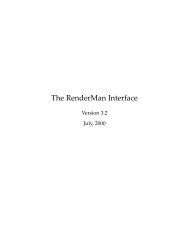Automatic rigging Toll for centipedes and millipedes - Bournemouth ...
Automatic rigging Toll for centipedes and millipedes - Bournemouth ...
Automatic rigging Toll for centipedes and millipedes - Bournemouth ...
Create successful ePaper yourself
Turn your PDF publications into a flip-book with our unique Google optimized e-Paper software.
Figure 8: Motion path comparison between a walking millipede <strong>and</strong> a runningcentipedepath, but when <strong>centipedes</strong> are running or swimming, they tend to move likesnakes. In such a case, their spine looks more like a sinus function <strong>and</strong> less likea curve following a path. Besides walking, <strong>millipedes</strong> explore their environmentmoving the spine to look around. They lift their front body <strong>and</strong> move it sideby side. A similar motion happens if a millipede wants to change its direction.In this case, it lifts the front body only as much as needed to lift the front legsfrom the ground <strong>and</strong> moves the spine sidewards. Finally, it continues to walkinto the new direction. Besides its front body it can also lift central segmentsof the spine or the back. This behaviour can be seen in the video of NationalGeographic [Nat07] or in figure 8, where the centipede lifts the central segmentsof its body to carry babies or where it lifts the back during the fight against themouse.LegsThe movement of the legs is actually the most fascinating part of myriapoda,because the legs look like a wave while walking 5 . This wave is the result ofeach pair of legs being in phase, but slightly out of phase to the previous pair.To avoid stumbling about its legs, each pair is never moved further than theprevious one. The motion of each leg can be subdivided into two parts. Duringthe transfer stage the leg is lifted <strong>and</strong> moved <strong>for</strong>ward. In opposite to that,the leg stays attached to the ground <strong>and</strong> pushes the body <strong>for</strong>ward during thepropulsive stage. There are different theories that try to simulate the motion ofeach leg. The first was mentioned by Sinclair, who reports that the legs movein a set of five [Sin85]. Another model is mentioned in [Sat04]. It is based5 see there<strong>for</strong>e the enclosed video12















